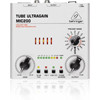Behringer TUBE ULTRAGAIN MIC200 Manual - Page 13
User interface, POWER, dB PAD, LOW CUT, PHASE REVERSE - settings
 |
View all Behringer TUBE ULTRAGAIN MIC200 manuals
Add to My Manuals
Save this manual to your list of manuals |
Page 13 highlights
13 TUBE ULTRAGAIN MIC200 User Manual 2.1 User interface (1) The GAIN control allows you to control the gain from +26 to +60 dB to the input signal. This control should be set all theway to the left when (dis) connecting a sound source from the MIC200. When all connections are made, slowly start raising the gain control. (2) We recommend using the LED meter to adjust gain. The LED chain displays the output signal level in dB. Please make sure that the clip LED never lights up permanently. It should light up only at peak signals, but it should never be on all the time. (3) If your MIC200 is connected to the mains via the enclosed power supply unit, the POWER LED lights up to indicate that your MIC200 is running. (4) The 20 dB PAD switch reduces the input sensitivity by 20 dB (switch pressed). The appropriate setting depends on the equipment connected. Generally speaking, lowering the signal level in mic applications is not recommended. No matter what your application is, the clip LED warns you to reduce the gain setting to avoid distortion. (5) This +48 V switch activates the phantom power supply for the XLR input. Phantom power supply is required for operating condenser microphones. Dynamic microphones require no phantom power. (6) Press the LOW CUT switch to eliminate undesired subsonic noise, such as floor rumble. (7) With the PHASE REVERSE switch, the input signal is reversed by 180°. This function is available for both mic and line signals. Use this function in a multi-microphone setup if you detect phase cancellations in specific frequency bands.















